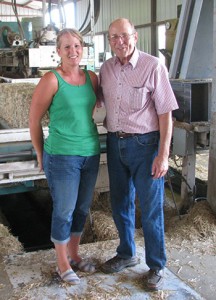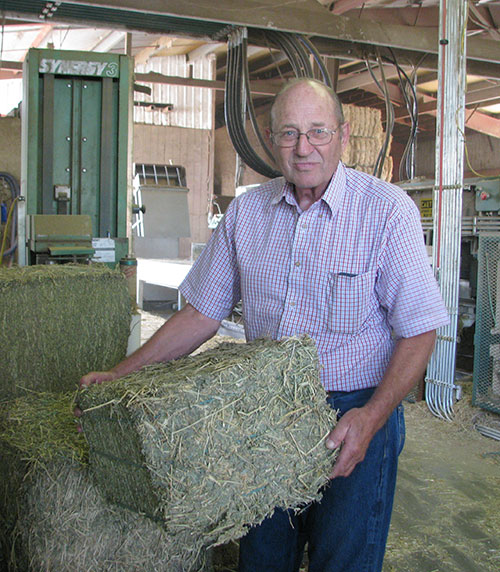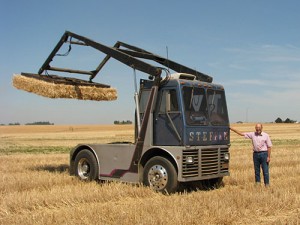
By Brenna Wiegand
As local farmers cut their hay fields and compress it into hay bales, there’s farmer they can thank for making revolutionary changes to their industry.
It’s not that Stan Steffen set out to make changes.
But when life happens, as it does, he needed to change his game plan.
Stan developed ways to streamline every stage in the haying process, including a system that accumulates and binds several bales into one, and ways of compressing bales to one-third their original size, creating a product that can be sliced and diced to meet any customer’s need.
Stan and Ruth Steffen are the backbone of Steffen Hay Co., a family owned corporation on 300-acres settled by Stan’s great-grandmother and her two sons in 1877.
He will host this year’s 118th National Hay Association Convention Sept. 10-13 at the Grand Hotel in Salem. Steffen, NHA’s current president, expects “two or three hundred” people from across the country.
A humble man, Stan does what needs to get done to take care of his family and the family farm. During Stan’s watch, vehicles and machines that revolutionized haying and changed the shape of the bale as it had been known poured forth from the operation near the intersection of Silverton and Howell Prairie roads.
Steffen, now 70, did his first farming projects as a sophomore at Silverton High School in Lloyd Dahlin’s vocational agriculture class.
“It was 1957, and if I remember right I had a calf and a patch of black raspberries,” he said. “I even tried to grow some peanuts. I don’t know why I did all those crazy things. I guess I never got that serious about farming. My interests were mostly in mechanical things – electronics, short wave radios and stuff like that.”
Stan Steffen is president of the National Hay Assoc.
Honor: In 2002, Stan received The Haymaker Award,
which honors members who show outstanding service,
dedicated leadership, generous contributions,
exceptional performance, or inspiring commitment
to the NHA and the hay industry. The award is the
highest honor that a NHA member can receive.
Best quote: “If there’s not hay to bale in heaven,
I don’t want to go there,” he said with an easy grin.
“You know the old song, ‘If there’s not Jack Daniels,
I don’t want to go’; this is my vice.”
Family: Stan and Ruth Steffen’s children and their
spouses are: Dave and Rebekah Steffen; Annette and
Tom Aman; Dale and Jordan Steffen; Scott and Melissa
Steffen; Janie and Pat Twede; Troy and Sarah Steffen
and Michael and Meghan Steffen. They have 20 grandchildren.
In 1963, his dad retired and Stan and his brother Wayne, eight years older, went in on the farm together. Stan married Ruth deVries – Wayne had married her sister Doryce two years earlier.
Stan proved handy with machines and even persuaded his dad to “get some decent tools.”
“He went to Wilco Farmers and bought me a toolbox – oh that made my day – the best thing that ever happened to me was that box of tools. I still have most of them today,” Stan said.
Stan and Wayne were just busy farming and didn’t really think about modernizing their equipment. That is, until a few years later when a tractor tire fell on Wayne, paralyzing him from the waist down.
Stan realized how much he had relied upon his older brother.
“I went up there to OHSU every week and we spent time together and talked about how we were going to carry on,” Stan said. “Wayne helped me to look forward. He said, ‘Hey, we’re going to make this work; we’re going to keep on going.’”

The Steffens’ mechanical savvy met the challenge. Stan started adapting his hay loader so when Wayne came home he could continue picking up bales and loading trucks – using only hand controls.
“Ed and Betty Shuholm gave us their old ’59 Pontiac for the chassis,” he said. “When you want to do something and there’s no way to do it, you figure out a way.”
Wayne wasn’t home long before he adapted his large grain-hauling rig.
“He figured out how to fit it with hand controls,” Stan said. “Twenty-two tons of grain and he’d haul it up to Portland every day with nothing but hand controls.”
As the years went on and the Steffens kept producing inventive new machines, Stan started a Saturday morning Bible study with some local guys, several of whom became employees and part of a think tank that later created Steffen Systems.
“We were studying First John and it was telling us how relationships should develop,” Stan said. “We worked to build a community of people that worked together … We kind of looked at the Amish and … were envious.
“Here in the Pratum area people had become so independent that they wouldn’t even work together or share equipment; wait for your neighbor to fail so you could grab his land, too. In 1970, I erected a shop and we started building the machines together,” Stan said.
“Most of the technique and construction I learned from the guys that worked for me – Rick Reiger, Al Tschiegg…,” Stan said. “Paul Bolliger from Switzerland was a machinist; Rick would take our basic rough machine and dress it up to where it was pretty merchandise to sell; my brother Don knew hydraulics and computers. So we learned together to take time and make it nice.”

During busy seasons, the Steffens farmed out a lot of work to Silverton Road machinist Paul Acklimeyer.
Later on, Stan, Bolliger, Don and his son Gerald formed Steffen Systems with their wives.
“I didn’t want to be heading up all this stuff by myself, it was just getting too big,” Stan said.
The community at large was taking notice.
“Old Dr. Pettit loved machines and was always interested,” Stan said. “I’d go in there and it didn’t matter how sick I was; he wouldn’t even look at me until I told him all that I was doing with the machines. After I built the bale loader he told me one day ‘I wish you’d build every hay farmer a machine like this so I’d quit seeing all these back injuries.’”
Once the National Hay Association saw what they were up to, Steffen Systems began earning national attention. In 1989 Stan sold Steffen Systems to his son David, whose shop is just down the road from the farm.
Stan’s son Troy is heading up a new venture into retail sales; daughter Janie Twede and other family members are at work around the place on any given day, grandkids frolicking in the yard. But in between the triumphs have been failures and twice he had to start over.
“I’m glad we did what we what we did,” Stan said. “We both went to Pratum Church and had a strong feeling that God was in control of both of our lives; that it was a three-way partnership. We had to remind ourselves of that often, but we really didn’t fear the future because of that. I think that’s one of the reasons we succeeded as well as we did. We weren’t afraid to do whatever we were called to do.”
As the president of the National Hay Association, Stan is looking forward to welcoming hay farmers from around the United States to Oregon.
The subjects of this year’s convention are twofold: Steve Fransen, forage expert from the University of Washington will talk about a new hay product that can be exported at higher moisture levels through compression and airtight wrapping – a boon, they hope, to hay farmers in high rainfall areas.
Keynote speaker Arden Andersen will speak on the importance of good soil management for healthier people.
“Many farmers are pretty protective of their chemicals because of the way they’ve helped us produce more, better-looking product with less labor … but it turns out the product isn’t better; we’re kind of cheating Mother Nature with some of the chemicals we use,” Stan said.
Amongst his many awards is the plaque that adds Steffen’s name to those of industry giants – the industry’s highest honor, bestowed by the National Hay Association for contribution to the industry.
When a bale fell and broke Stan’s hip six years ago, he thought his farming days were over (though he made a remarkable recovery). He and Ruth gathered their five sons and two daughters together that Thanksgiving.
“With my accountant acting as the MC we told them we’d decided we were going to hang it up; the kids were going to decide what they wanted us to do for the rest of our lives, but they voted unanimously to keep the farm together and run it as one business,” he said. “That’s what we wanted, really.”